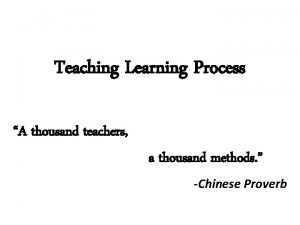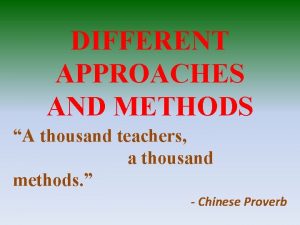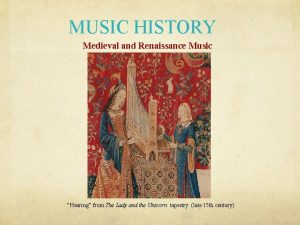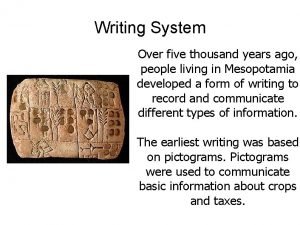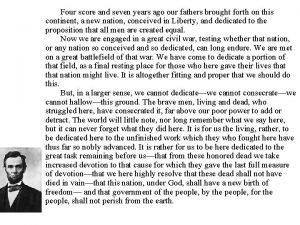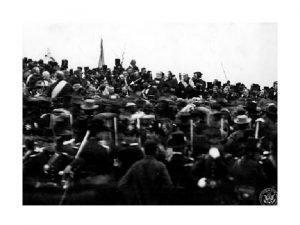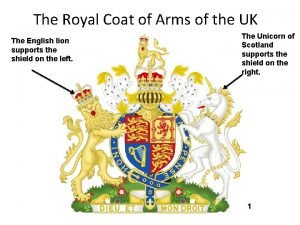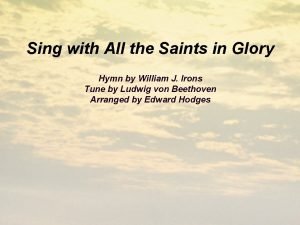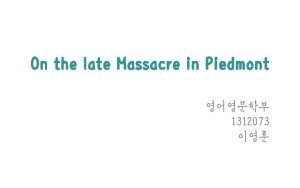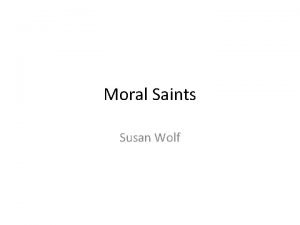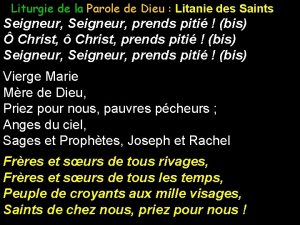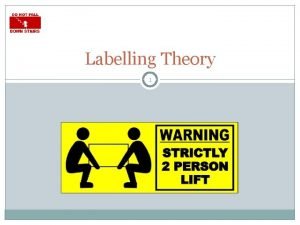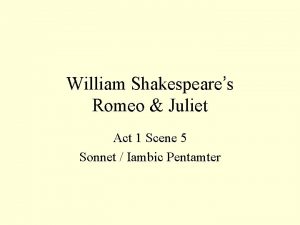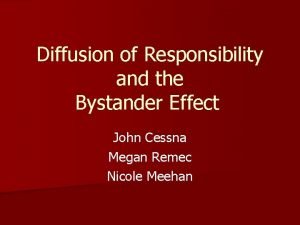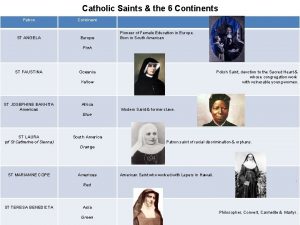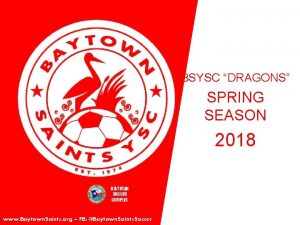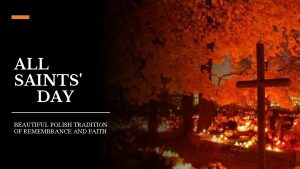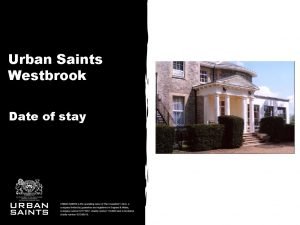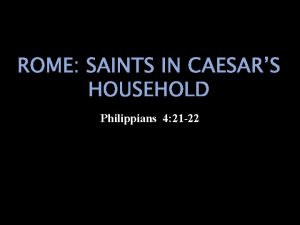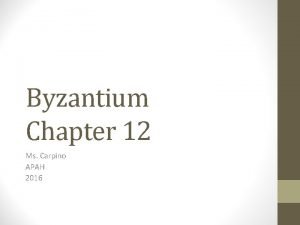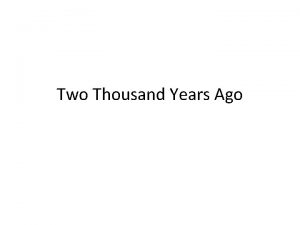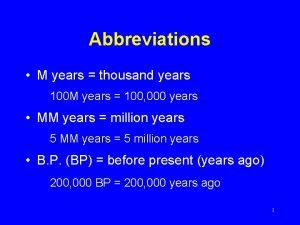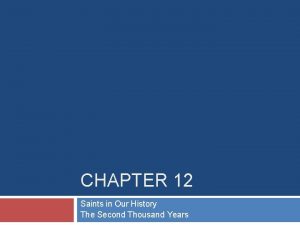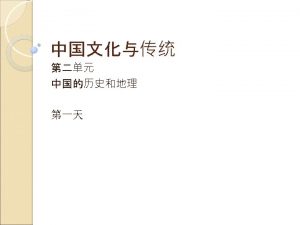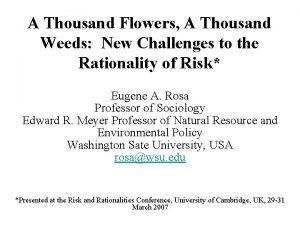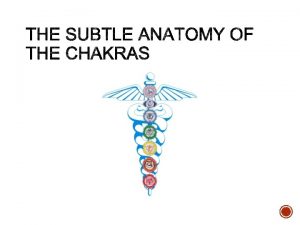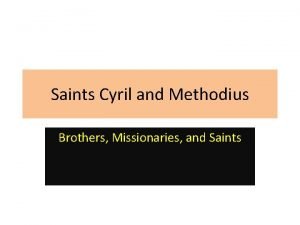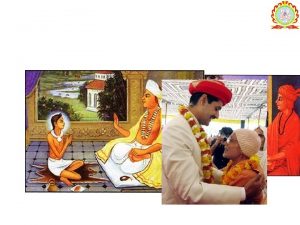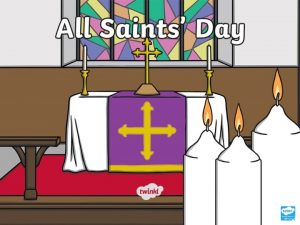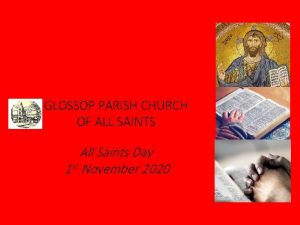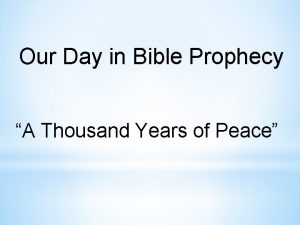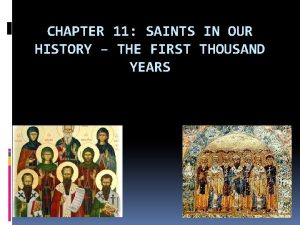Saints in Our History The Second Thousand Years





























- Slides: 29

Saints in Our History: The Second Thousand Years Chapter 12 1

Lesson One THE CRUSADES 2

Homework Quiz Write the QUESTION and ANSWER. 1. Which Saint called for the second crusade? 2. Which Monastery was founded by St. Bernard? 3. When the Church was moving into the 11 th and 12 th century, what was one of her first concerns? 3

Islam • Founded by Mohammad (570 -633 A. D. ) • “Islam” comes from the word “Aslama, ” meaning surrender—Peace that comes with surrender to God. – “Muslim, ” means “believer”—an adherent to Islam. • Basic tenants: – Monotheism • Believe that Jesus is a prophet and that God is not a Trinity. • Believe that Jesus ascended into heaven prior to the events surrounding the Last Supper. – Strict Morality • No alcoholic drink, strict regulations on clothing, and strict fast laws. – Equality • “We are all equal in the sight of God. ” 4

Islam cont… • Five Pillars of Islam: 1. 2. 3. 4. 5. A profession of faith. Ritual Prayer. Almsgiving. A strict fast during the holy month of Ramadan. A pilgrimage during one’s life to Mecca. • His views are met with opposition in his own tribe (Mecca) and he is exiled. – He travels to Medina in 622. Here, he organized a small army and returns to Mecca. – After 25+ battles, Muhammad conquers Mecca in 630. After ~8 years of battle, they have ~2 years of official rest before Muhammad dies in 633. 5

A Boiling Point • In 1009 Caliph Hakim ordered the destruction of the Holy Sepulcher. By 1014, 30, 000 churches had been burnt. • Christians had to wear distinctive clothing, Church property was confiscated, crosses were burnt, and mosques were built atop Churches. • Christians faced beatings, robberies, and many other types of harassment. 6

The Beginning • The Crusades came at a boiling point, just after Constantinople fell to the Turks. The Pope saw it as an opportunity to accomplish many tasks: – Expansion of the Holy Roman Empire – Provide for the safe travel of pilgrims – Unite previously excommunicated kings and assert Papal dominance over the European kings. • French, British, and German – Demonstrate the Pope’s primacy over all of the kings of Europe. • He would be the only one capable of bringing all of the kings of Europe together. – Stories of Islamic barbarism in Spain • Mass executions to end uprisings and a massacre of Jews. 7

• The Reconquista – This took place in Spain, starting in 1066, a four century effort was begun, in order to push Islam out of Spain. – The final Muslim city to fall, surrendered in 1492, after nearly 800 years of Muslim rule in Spain. • The Crusades: – Both the Eastern and Western Church were facing the threat of the invading Islamic peoples. – Constantinople was taken by the Turks in 1084. This would call for the West to come to the help of the East. – The First Crusade began in 1096. • The Pope called together the kings of England, France, and Germany to bring soldiers to the fight. 8

The Council of Clermont • In 1095, Pope Urban II called for the first Crusade – To retake the city of Jerusalem, for Christianity. • Enthusiasm was so high that red paint, which was used for the Jerusalem Cross very quickly ran out. • Armies were to be raised for the fight to retake Jerusalem. – The Church sought strict control over the armies. • Volunteers must be approved by their parish priest. • Must take a crusading vow. • Desertion meant excommunication. 9

Homework Quiz Write the QUESTION and ANSWER. 1. According to the text, which King of France led the last two crusades? 2. Did the Crusaders achieve their goal? Yes or no. 3. How do mendicant orders support themselves? 4. With the blessing of the Pope, St. Francis’ order was established as the Order of. 10

PRA Y 11

• People’s Crusade: – A people’s crusade led by Peter the Hermit was created. • 40, 000 -50, 000 undisciplined, untrained for war, and lacking in strategy set out for Jerusalem. • Violent group that attacked anyone that got in their way. • Upon reaching Asia Minor they were promptly slaughtered, leaving only 2, 000 -3, 000 survivors (false sense of security). • Church Sanctioned Crusades: – Four main armies were established, which amounted to nearly 70, 000 soldiers. • The majority of people interested in the Crusades were professional soldiers. – In 1096, the first army arrived in Constantinople and waited until the Spring of 1097, when the final armies arrived, to proceed towards Jerusalem. – 10, 000 soldiers reach Jerusalem and lay siege. After 40 days, the Crusaders breach the city and begin to kill the 40, 000 citizens. 12

Of All the Crusades • Of all the Crusades, the first was the only one that actually proved to be successful. – First Crusade was from 1096 -1099 – Second Crusade was from 1147 -1149 • German and French forces; did not fight together, routed by the Turks. – Third Crusade was from 1187 -1192 • Turks recapture Jerusalem in 1187. Recaptured land along Mediterranean coast but did not get Jerusalem. – Seventh 1248 -1250 and Eighth Crusades 1267 -1270 • Both consisted of invading forces coming from the Mediterranean Sea. • In total there were 8 official Crusades over the span of 174 years. 13

Effects of the Crusades • As a result of the crusades, Jerusalem remained under Christian rule for 88 years. – Due to a peace treaty between the Holy Roman Emperor and the Sultan of Egypt that ended the Sixth Crusade, Jerusalem was under Christian rule from 1229 -1244. • The Crusades ended with mixed results. – By the end of the Crusades, Jerusalem remained under Islamic rule. – The Islamic advance into Europe was halted and subverted. – In addition, it showed that the countries of Europe could unite into one force, against a common enemy. 14

More Effects “The manifestation of a spiritual impulse springing from the depth of a man’s soul, the heroic expression of a faith which found no satisfaction unless in sacrifice, an answer to the call of God. ” • For the vast majority of the participants, it was a spiritual journey—having romanticized taking the City of Jerusalem. – This was quickly lost after the capture and fall of Jerusalem during the Crusades • The Crusades also led to many societal advances: – Navigation – Medicine – Philosophy – Preferential treatment of women—leading to chivalry. 15

Why Jerusalem? • Judaism: – This was the Holy Land that was promised to them by God, through Abraham. • Christianity: – This is the land where Jesus lived and founded His Church. • Islam: – The location of a shrine that was founded by Mohammad, Al Aqsa Mosque. 16

Is ISIS Really like the Crusades? • https: //www. youtube. com/v/I_Toc. V 94 Bo&autoplay=1 17

New Religious Orders Lesson Two 18

New Religious Orders • Two new Religious Orders came about in the Middle Ages: – The Franciscans 1209 – The Dominicans 1216 • Both orders were mendicant. This meant that they lived by begging—they received all of their belongings by begging for them. • Mendicants were a departure from traditional monastic orders, because mendicants did not grow their own food and make most of their belongings. 19

St. Francis of Assisi • Francis was the son of a wealthy man, who rejected his father’s wealth and decided to live a life of poverty, by caring for the poor. • One day while praying in a Church, Francis heard a cross say to him, “Francis rebuild my Church. ” At this, Francis set out to convert and minister to those that were spiritually poor. • Founded the Order of Friars Minor 20

St. Clare • She was a young woman from Assisi, that also desired to live a life of poverty and minister to the needy and sick. • Clare founded the Poor Clares, which followed the same rule that St. Francis had established for the Franciscans. 21

• Dominicans: – St. Dominic founded Order of Preachers – Their work was to convert the Albigensians that were living in Southern France. • The Albigensians believed that matter was evil. – They emphasized scholarly learning for their members so that they could grow in the Faith and preach it well. • St. Thomas Aquinas – Born in 1225, to a wealthy family. – Studied at Monte Cassino, University of Naples, and University of Paris. • He encounters the Dominicans in Naples and became a professor in Paris. – In 1274, while on the way to the Council of Lyons, Thomas fell ill and died. 22

• Avignon Papacy (1309— 1376) – It was started by Pope Clement V and was ended by Gregory XI – It started when a deadlocked conclave finally elected a new pope, who moved the Vatican to Avignon. Over the course of the next 67 years, the papacy began to be heavily influenced by the French monarch. • St. Catherine of Siena – Catherine was born in 1347 and died in 1380. – She was a member of the Third Order of St. Dominic. – She wrote vigorously to Pope Gregory XI, urging him to return the papacy to Rome. 23

Western Schism • After the papacy was returned to Rome, there was a dispute over the actual pope. This conflict ended in with the Council of Constance (1414— 1418) in, which stated that the Avignon conclave of 1378 was invalid, and a new, legitimate pope was elected in 1417—Pope Martin V. • The Western Schism was not officially resolved until 1438, when all other claimants to the papal throne either renounced their authority or died. In all, there were two Anti-popes. 24

Lesson Three PROTESTANT REFORMATION 25

Protestant Reformation • Martin Luther – Catholic, Augustinian Priest. – 95 Theses (1517) in a forum for public discourse. • Told to cease and desist by his superior; refused. Exiled to Germany. – Formation of the Lutherans • King Henry VIII – Concerned about not producing a male heir, sought divorce from his wife, Catherine of Aragon. – Split begins in 1529, finalized in 1534 (Act of Supremacy). – Formation of the Anglicans. 26

Council of Trent (1545 -1563) • Called by Paul III. – Indulgences could no longer be sold. – Priests could not embezzle Church funds for the benefit of family. – Formalized studies for priests, recruitment of future priests was to be focused on poor, at least 12 years old, and legitimate. – Problem priests were to be dismissed immediately. – Reaffirmed Canon. – Spiritual life of the clergy was regulated: • Celebrate Mass once, every day. • Monthly confession • Assist at the Cathedral for major feasts. 27

Lesson Four MODERN TIMES 28

Modern Times • Modernism—teachings on faith and morals should change and evolve and that there is no objective revelation from God on which Christianity is based. – Pope Saint Pius X denounces this idea. • Atheistic Regimes – Killed more people in the last 100 years than any religion, ever. • St. Maximilian Kolbe – Arrested by the Gestapo and sent to Auschwitz, there he sacrificed himself for the sake of a man that was sentenced to death. 29
 A thousand teachers, a thousand methods
A thousand teachers, a thousand methods Rounding numbers to the nearest hundred thousand
Rounding numbers to the nearest hundred thousand Define teaching method
Define teaching method The middle ages spans nearly one thousand years.
The middle ages spans nearly one thousand years. Why did the barley sign change shape
Why did the barley sign change shape Sheep years to human years
Sheep years to human years 300 solar years to lunar years
300 solar years to lunar years How long ago was four score and seven years
How long ago was four score and seven years Four score and seven years ago our fathers
Four score and seven years ago our fathers How long is four score and seven years ago
How long is four score and seven years ago 27 miles per gallon into kilometers per liter
27 miles per gallon into kilometers per liter Prayers of saints revelation
Prayers of saints revelation Saints of uk emblems
Saints of uk emblems For all the saints hymn
For all the saints hymn Scott phillips software developer
Scott phillips software developer Avenge o lord thy slaughtered saints
Avenge o lord thy slaughtered saints Moral saint
Moral saint Litanie de la parole de dieu
Litanie de la parole de dieu Labelling theory lemert
Labelling theory lemert Interesting facts about all saints day
Interesting facts about all saints day Metaphors in romeo and juliet act 1, scene 5
Metaphors in romeo and juliet act 1, scene 5 Diffusion responsibility definition
Diffusion responsibility definition Patience of the saints meaning
Patience of the saints meaning Polish saints female
Polish saints female Baytown soccer complex
Baytown soccer complex All saints day poland
All saints day poland Urban saints westbrook
Urban saints westbrook Saints in caesar's household
Saints in caesar's household Virgin and child between saints theodore and george
Virgin and child between saints theodore and george Thinking language and intelligence
Thinking language and intelligence
